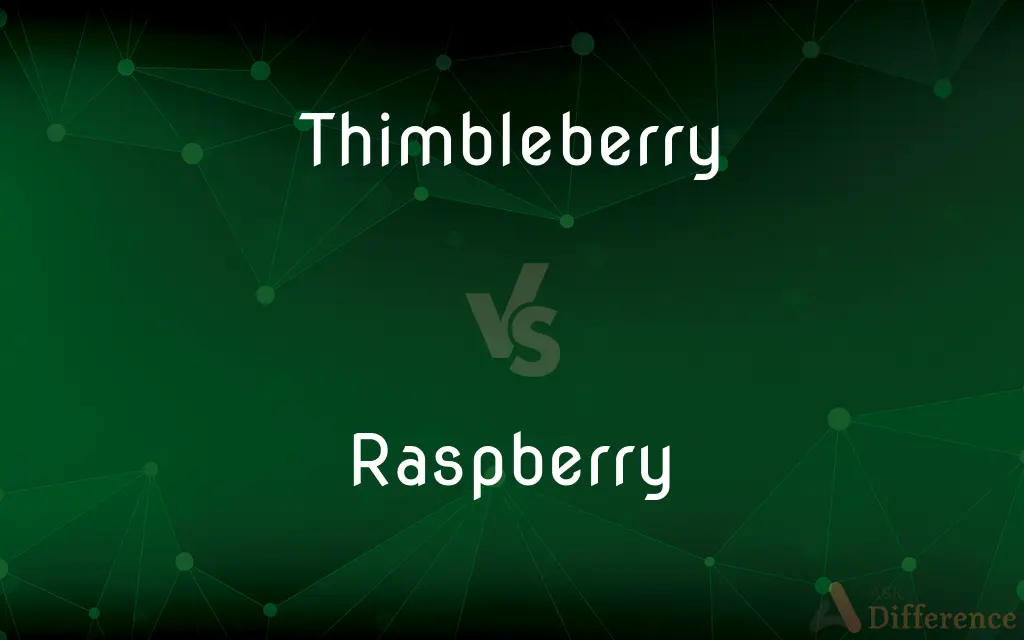Thimbleberry vs. Raspberry — What's the Difference?
By Maham Liaqat & Fiza Rafique — Updated on March 28, 2024
Thimbleberry is a wild berry with a soft, velvety texture, while raspberry is a widely cultivated berry known for its sweet flavor.

Difference Between Thimbleberry and Raspberry
Table of Contents
ADVERTISEMENT
Key Differences
Thimbleberry, belonging to the genus Rubus like the raspberry, is known for its large, flat, and soft berries that lack the firmness of raspberries. Its berries are delicate, with a unique, mildly sweet flavor, and are often not commercially cultivated due to their fragile nature. On the other hand, raspberries are firmer, making them suitable for commercial cultivation and widespread distribution. Raspberries come in various colors, including red, black, and golden, each with its distinct flavor profile ranging from sweet to tart.
The plants themselves present notable differences. Thimbleberry plants have large, maple-like leaves, and are known for their beautiful white flowers, making them popular in ornamental gardens as well as wild settings. They do not have thorns, which makes foraging for their berries a less prickly affair compared to raspberries. Raspberry plants, however, are typically equipped with thorns and have smaller, pinnate leaves. Their flowers are usually white to light pink, leading to the colorful berries that follow.
In terms of cultivation and use, thimbleberries are mostly wild-harvested and used locally in jams, pies, and fresh eating, mainly due to their soft texture and difficulty in transportation. Raspberries, with their firmer structure, are widely cultivated and used in a vast array of culinary applications, from fresh market fruits to jams, jellies, desserts, and even in beverages.
Nutritionally, both berries offer health benefits, including high levels of vitamin C, dietary fiber, and antioxidants, though the exact nutritional profile can vary between the two. Raspberries, however, might be slightly more accessible for nutritional comparison due to their commercial availability and the consequent abundance of nutritional data.
Both thimbleberries and raspberries thrive in similar climates, preferring cooler, temperate regions. However, thimbleberries are more commonly found in wild, wooded areas or along streams, showcasing their preference for moist, well-drained soils and partial shade, whereas raspberries are more adaptable and can be found both in wild settings and in cultivated gardens or farms.
ADVERTISEMENT
Comparison Chart
Texture
Soft and velvety
Firm and juicy
Cultivation
Not commonly cultivated, mostly wild
Widely cultivated, both commercially and in gardens
Plant Characteristics
Large, maple-like leaves, no thorns
Smaller, pinnate leaves, usually with thorns
Uses
Local jams, pies, fresh eating
Diverse culinary uses, including fresh consumption, jams, and beverages
Flavor
Mildly sweet
Ranges from sweet to tart
Color
Red
Red, black, golden
Flowers
White, ornamental
White to light pink
Habitat
Wild, wooded areas, prefers moist soils
Adaptable, found in both wild and cultivated settings
Compare with Definitions
Thimbleberry
Large, maple-like leaves.
The thimbleberry's distinctive leaves make it easily identifiable in the wild.
Raspberry
A widely cultivated berry known for sweetness.
Raspberries from the garden were used to make a delicious pie.
Thimbleberry
A wild berry with a soft texture.
We picked thimbleberries along the hiking trail, enjoying their unique flavor.
Raspberry
Used in a wide range of culinary applications.
She added fresh raspberries to the salad for a burst of flavor.
Thimbleberry
Used in local culinary applications.
Local chefs use thimbleberries to create unique, seasonal jams.
Raspberry
Adaptable to various growing conditions.
Raspberry bushes have thrived in both the sunny and shaded parts of the garden.
Thimbleberry
Grows in moist, well-drained soils.
Thimbleberry thrives along the stream, where the soil stays moist.
Raspberry
Comes in various colors.
The red and black raspberries were ripe for picking today.
Thimbleberry
Not commonly cultivated.
Thimbleberry plants adorn wild landscapes, their berries a treat for those who encounter them.
Raspberry
Smaller, pinnate leaves and thorny plants.
Carefully picking raspberries, he avoided the plant's thorns.
Thimbleberry
Any of several raspberries, especially Rubus parviflorus of western North America, having edible, thimble-shaped, usually red aggregate fruit.
Raspberry
(Slang)A derisive or contemptuous sound made by vibrating the extended tongue and the lips while exhaling.
Thimbleberry
The fruit of any of these plants.
Raspberry
The raspberry is the edible fruit of a multitude of plant species in the genus Rubus of the rose family, most of which are in the subgenus Idaeobatus. The name also applies to these plants themselves.
Thimbleberry
Rubus parviflorus, a species of Rubus, native to western and northern North America, from Alaska east to Ontario and Minnesota, and south to northern Mexico.
Raspberry
Any of various shrubby, usually prickly plants of the genus Rubus of the rose family that bear edible fruit, especially R. idaeus of eastern North America and Eurasia.
Thimbleberry
The fruit of the above plant.
Raspberry
The aggregate fruit of any of these plants, consisting of many small, fleshy, usually red drupelets.
Thimbleberry
The black raspberry, Rubus occidentalis.
Raspberry
A moderate to dark or deep purplish red.
Thimbleberry
A kind of black raspberry (Rubus occidentalis), common in America.
Raspberry
The plant Rubus idaeus.
Thimbleberry
Shrubby raspberry of eastern North America having showy rose to purplish flowers and red or orange thimble-shaped fruit
Raspberry
Any of many other (but not all) species in the genus Rubus.
Thimbleberry
White-flowered raspberry of western North America and northern Mexico with thimble-shaped orange berries
Raspberry
The juicy aggregate fruit of these plants.
Thimbleberry
Raspberry native to eastern North America having black thimble-shaped fruit
Raspberry
A red colour, the colour of a ripe raspberry.
Raspberry
(colloquial) A noise intended to imitate the passing of flatulence, made by blowing air out of the mouth while the tongue is protruding from and pressed against the lips, or by blowing air through the lips while they are pressed firmly together or against skin, used humorously or to express derision.
Raspberry
A cripple.
Raspberry
Containing or having the flavor/flavour of raspberries.
Raspberry
(color) Of a dark pinkish red.
Raspberry
To gather or forage for raspberries.
Raspberry
(colloquial) To make the noise intended to imitate the passing of flatulence.
Raspberry
The thimble-shaped fruit of the Rubus Idæus and other similar brambles; as, the black, the red, and the white raspberry.
Raspberry
Woody brambles bearing usually red but sometimes black or yellow fruits that separate from the receptacle when ripe and are rounder and smaller than blackberries
Raspberry
Red or black edible aggregate berries usually smaller than the related blackberries
Raspberry
A cry or noise made to express displeasure or contempt
Common Curiosities
Can you eat thimbleberries?
Yes, thimbleberries are edible and enjoyed for their unique, mildly sweet flavor.
Why aren't thimbleberries commonly found in stores?
Their soft texture makes them difficult to transport without damage, so they are not widely cultivated for commercial markets.
Are raspberries and thimbleberries related?
Yes, they both belong to the genus Rubus and share some similarities but have distinct differences in texture, taste, and cultivation.
Is there a nutritional difference between thimbleberries and raspberries?
Both are high in vitamin C, dietary fiber, and antioxidants, though detailed nutritional comparisons may vary due to the widespread availability of raspberries for analysis.
Can thimbleberry plants be used for landscaping?
Yes, their large, attractive leaves and beautiful white flowers make them popular in ornamental gardens.
Can raspberries grow in the wild?
Yes, raspberries can grow in the wild, but they are also widely cultivated in gardens and farms.
What makes raspberries firm compared to thimbleberries?
Raspberries have a more robust structure and are less delicate, making them suitable for commercial harvesting and transport.
Are all raspberries red?
No, raspberries can be red, black, golden, and even purple, depending on the variety.
How do you identify a thimbleberry plant?
Look for its large, maple-like leaves, white flowers, and the absence of thorns, which distinguish it from other Rubus species.
Can you make wine from thimbleberries or raspberries?
Yes, both berries can be used to make wine, though raspberry wine is more common due to the berry's availability.
How do you use thimbleberries in cooking?
They are often used in local, seasonal recipes for jams, pies, or eaten fresh, similar to other berries.
Are thimbleberries as sweet as raspberries?
Thimbleberries tend to have a milder sweetness compared to the often more pronounced sweet-tart flavor of raspberries.
Can raspberries and thimbleberries cross-pollinate?
While they are related, cross-pollination is unlikely due to differences in their specific genetics and flowering times.
Do thimbleberries and raspberries require the same growing conditions?
They thrive in similar climates but differ in habitat preferences, with thimbleberries favoring more wild, moist areas.
Share Your Discovery

Previous Comparison
Lever vs. Pull
Next Comparison
Known vs. UnknownAuthor Spotlight
Written by
Maham LiaqatCo-written by
Fiza RafiqueFiza Rafique is a skilled content writer at AskDifference.com, where she meticulously refines and enhances written pieces. Drawing from her vast editorial expertise, Fiza ensures clarity, accuracy, and precision in every article. Passionate about language, she continually seeks to elevate the quality of content for readers worldwide.
















































